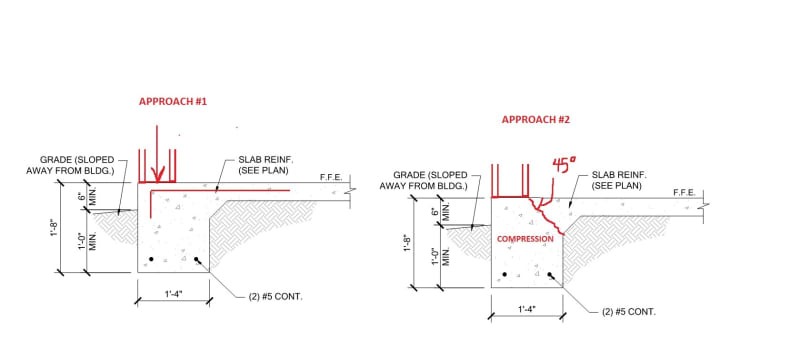In Residential Construction in Florida,
A lot of houses (1 and 2 story)are designed with Monolithic Footing with fiber mesh on top.
I have read multiple forums and re-searched online and asked around in my office and
I have not found calculations for monolithic footings with fiber mesh on top.
So far I have come across 2 approaches (See attached picture for reference):

1st approach: Assumes that the wall load will create a rotation at the heel of the footing and therefore will create a moment that needs to be counter-balanced with the slab. This approach ends up requiring top steel around the perimeter of the footing in order for the slab to work with the thickened edge. In most cases the area of steel required is more than wire mesh, and in theory this approach requires top rebar around e perimeter of the slab.
Pros of this approach: It Seems to be more in alignment with the footing design principles found in text books.
Cons of this approach: Having that perimeter steel(rebar) is not a common practice for 1 and 2 story houses construction in Florida.
2nd approach: Assumes a projection of the load from the base of the wall to the base of the footing at 45 deg. This approach seems to disregard the eccentricity from the load since the load ends up being distributed at the base of the footing as if the load was at the center of the footing.
Pros of this approach: It fits the construction practice of building (1 story houses and 2 story houses) with no rebar around the perimeter of the thickened edge slab.
Cons of this approach: There is no textbook or code (that I am aware of) that validates this approach for monolithic footings.
Please let me know which approach you go by and what is your basis. Please share any resources or calculation examples if possible.
A lot of houses (1 and 2 story)are designed with Monolithic Footing with fiber mesh on top.
I have read multiple forums and re-searched online and asked around in my office and
I have not found calculations for monolithic footings with fiber mesh on top.
So far I have come across 2 approaches (See attached picture for reference):

1st approach: Assumes that the wall load will create a rotation at the heel of the footing and therefore will create a moment that needs to be counter-balanced with the slab. This approach ends up requiring top steel around the perimeter of the footing in order for the slab to work with the thickened edge. In most cases the area of steel required is more than wire mesh, and in theory this approach requires top rebar around e perimeter of the slab.
Pros of this approach: It Seems to be more in alignment with the footing design principles found in text books.
Cons of this approach: Having that perimeter steel(rebar) is not a common practice for 1 and 2 story houses construction in Florida.
2nd approach: Assumes a projection of the load from the base of the wall to the base of the footing at 45 deg. This approach seems to disregard the eccentricity from the load since the load ends up being distributed at the base of the footing as if the load was at the center of the footing.
Pros of this approach: It fits the construction practice of building (1 story houses and 2 story houses) with no rebar around the perimeter of the thickened edge slab.
Cons of this approach: There is no textbook or code (that I am aware of) that validates this approach for monolithic footings.
Please let me know which approach you go by and what is your basis. Please share any resources or calculation examples if possible.
